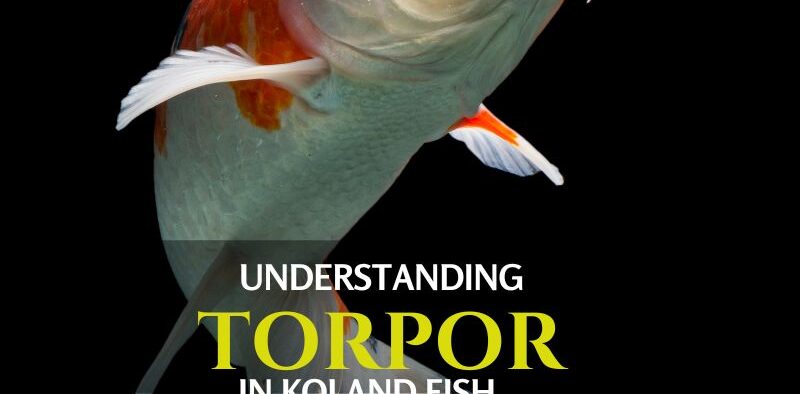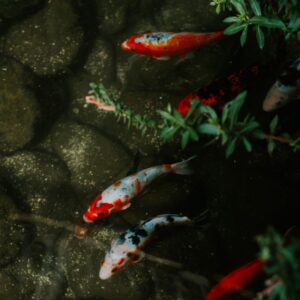Understanding Torpor in Fish: A Long Winter’s Nap
Share

As winter approaches and the air turns crisp, koi owners might notice a change in their beloved fish. Koi become less active, spending more time near the bottom of the pond, and their feeding frenzy slows. This isn’t a sign of illness, but a fascinating survival tactic called torpor. We’ll delve into the world of torpor in fish, specifically focusing on koi, to ensure your pond residents have a peaceful and healthy winter slumber.
Understanding Torpor: Nature’s Built-in Energy Saver
Torpor is not quite hibernation, but a close cousin. Unlike true hibernators who enter a deep sleep, fish in torpor experience a significant decrease in their metabolic rate. This means their bodies slow down, requiring less energy to function. It’s like putting their biological processes on low power mode to conserve precious resources during the colder months.
What Triggers Torpor?
Koi and other pond fish are attuned to subtle shifts in their environment. As day length shortens and water temperatures drop (typically below 50°F or 10°C), their bodies receive the signal to enter torpor. This amazing adaptation allows them to survive on minimal energy reserves when food becomes scarce and the water gets too cold for normal activity.
Signs Your Koi Are in Torpor
Here’s how to recognize when your koi have entered their winter slumber:
- Reduced Activity: They’ll become less active, spending most of their time near the bottom of the pond, often hovering motionless.
- Decreased Appetite: Their feeding frenzy comes to a halt. They simply don’t require as much food when their metabolism is slowed down.
- Slower Movements: Any movements they do make will be sluggish and deliberate.
Don’t confuse torpor with illness. If your fish are gasping for air at the surface, have unusual body positions, or show signs of discoloration, consult a veterinarian or koi specialist.

Keeping Your Koi Cozy During Torpor
While koi are well-equipped for winter with their natural antifreeze (glycoprotein), proper pond care during torpor is essential for their well-being. Here are some key tips:
- Keep a Hole in the Ice: If your pond freezes over, create a small hole to allow gas exchange. This is crucial to prevent suffocation.
- Aeration: Consider adding an aeration system to maintain oxygen levels, especially if your pond is heavily stocked. You can also cover a portion of the pond surface with shade cloth to help insulate the water.
- Partial Water Changes: Although filtration might be reduced, occasional water changes are still beneficial to remove waste products.
- Pond Depth Matters: A deeper pond (at least 3-4 feet) provides a zone of warmer water near the bottom where your koi can find refuge.
Some people recommend turning waterfall features off. That is a decision that should be made based on your individual circumstances. In Arizona, we were able to leave our filter and pump on all year. However, while we do freeze, we don’t have extended freezes for weeks at a time. Discuss your situation with other local koi keepers to get the best advice.
Feeding During Torpor: Less is More
Resist the urge to feed your koi during torpor. Their digestive systems are sluggish, and excess food can pollute the water. This can result in bacterial infections as the immune system of your fish are weakened during torpor. While it might seem counterintuitive, feeding your koi during torpor can actually be detrimental to their health.
Here’s why:
- Slowed Digestion: During torpor, a koi’s digestive system slows down significantly. Introducing food can overload their system, leading to digestive issues and water quality problems.
- Food Spoilage: Uneaten food settles at the bottom of the pond, decomposing and releasing harmful ammonia and nitrites. This can stress your koi and pollute the water, especially with reduced filtration during the colder months.
- Energy Conservation: Remember, the whole point of torpor is to conserve energy. Koi don’t need the extra energy required to digest food when their bodies are functioning at a minimal level.
So, when can you start feeding again? Wait until spring arrives and water temperatures consistently rise above 50°F (10°C). This signals to your koi that it’s time to ramp up their metabolism and become active again. Start with a small amount of high-quality, easily digestible food and gradually increase portions as their activity level increases.
Plants and Winter Pond Care: To Remove or Not to Remove?
The decision to remove plants from your koi pond during winter depends on the type of plants and your climate. Here in Arizona, our watercress and parrot feather came back with no problem at all. But, our hibiscus and lotus plants are going to need replacing. Here’s a breakdown:
- Submerged Plants: These plants often die back or become dormant in cold weather. While they won’t actively contribute oxygen or compete for nutrients, leaving them in can provide some shelter for your koi. However, if they decompose rapidly and contribute to organic waste, consider removing them.
- Marginal Plants: These plants growing around the edge of the pond might benefit from removal if they die back completely. Removing dead plant material prevents the release of unwanted nutrients into the water.
- Beneficial Bacteria: Remember, the beneficial bacteria living within your pond ecosystem play a crucial role in breaking down waste products. Leaving some plants, especially those with established root systems, can help maintain these beneficial bacteria populations throughout winter.
Overwintering Your Plants
If you decide to remove plants, don’t discard them completely. Healthy portions can be stored in a cool, protected location for replanting in spring. We kept ours in a makeshift aquarium made from a water barrel in our greenhouse. We used a submersible pump to keep water circulating.
With the proper care and maintenance, your koi will not only survive, but thrive when spring arrives a few short months later. When the temperatures warm up and you and your koi are feeling a little better about being outdoors, follow these tips to make their awakening a happy one.








